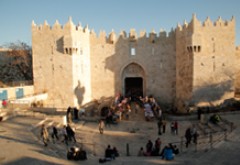The Byzantine period of stability, extending over three centuries, was interrupted by the arrival of the Sassanid Persian army, which stood outside the city walls in 614 AD, storming the city by force and destroying many of the city churches outside and inside the city walls, in addition to destroying its fortifications.
The fall of Jerusalem in this year at the hands of the Persians had an unprecedented echo around the world. The issue was not one of losing part of a world empire, but rather the loss of the holiest of Christian holy places, the Holy Cross, and Christ's tomb and cradle. This control did not remain for long, and did not result in any prominent architectural activity, except an attempt by the city to heal its bleeding wounds, clean the rubble, and try to restore some of the important churches. Meanwhile, the Persians acted as conquerors, and contributednothing to the city but destruction and massacres. Sources refer to a large massacre of clergymen and monks, as well as Christian believers near the Mamilla pool, where the remains of the Mamilla Islamic cemetery are found today. Christian sources mention that the number of the dead reached 33,877, in addition to large numbers of prisoners who were transported to Ctesiphon (Al-Mada'en), the Sassanid capital.
Hardly fifteen years passed since the Sassanid conquest when the stallions of Emperor Hercules raced towards the Jerusalem in 628 - 629 AD, retrieving the city and restoring it to the Empire. He started, under the supervision of Patriarch Modestos of Jerusalem to rebuild the churches and fortifications destroyed by the Persian invasion through a campaign to collect money from the faithful in the Byzantine Empire. The task was continued by Patriarch Safroneus , who would play an important role in the history of the city in the following years. But before this arduous task was completed, Abu Obaidah 'Amer Ibn Al-Jarrah was at the city gates, leading the Arab Muslim campaign to Jerusalem in the name of the Second of the Muslim Caliphs, Omar Ibn Al-Khattab in 636 AD. He negotiated with the Patriarch a surrender to the Arab forces, which had tightened its control over most of Bilad Al-Sham (Greater Syria), with only a few cities and pockets left, including Jerusalem, which was left to the second stage of the campaign. These forces did not only draft the future of Jerusalem for the following fourteen centuries, but also the history of large portions of the whole world.








